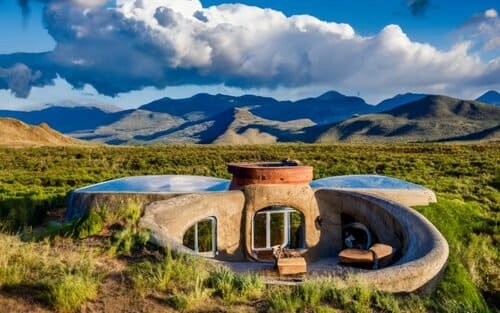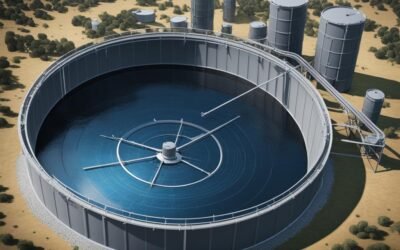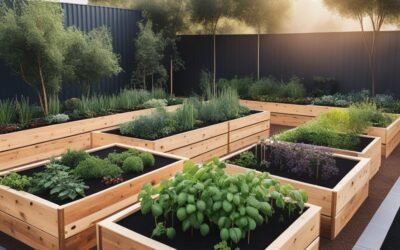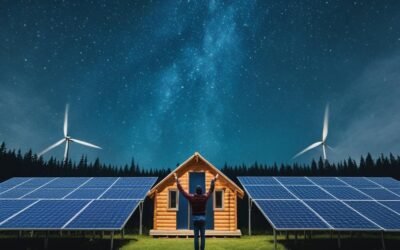I’d like to introduce you to the world of Earthships – unique homes that embrace sustainable living, eco-friendly construction, and off-grid capabilities. If you’ve ever wondered what an Earthship is or how it can revolutionize the way we live, then you’re in for a treat.
Earthships are not your typical houses. They are built using recycled or natural materials, such as recycled cans, glass bottles, and tires. These innovative homes are designed to be self-sustainable, utilizing renewable energy sources like wind and solar power to meet the energy needs of the residents.
But it doesn’t stop there – Earthships collect their own drinking water, treat their own sewage, and often have a greenhouse space for growing food inside. They are truly off-grid havens that allow homeowners to live in harmony with nature while reducing their environmental footprint.
Are you intrigued? Let’s delve deeper into the advantages of Earthships and how they embody the principles of sustainable architecture.
Key Takeaways:
- Earthships are sustainable homes constructed using recycled or natural building materials.
- They are designed to be self-sustainable, utilizing renewable energy sources like wind and solar power.
- Earthships collect their own drinking water, treat their own sewage, and often grow their own food.
- These eco-friendly homes are built off-grid, promoting a sustainable and environmentally conscious lifestyle.
- The use of recycled materials and passive solar design make Earthships a prime example of sustainable architecture.
The Advantages of Earthships
Earthships offer numerous advantages for those seeking to live a more sustainable lifestyle. With their off-grid capabilities and renewable energy sources, Earthships enable homeowners to live self-sufficiently. These eco-friendly homes minimize utility bills and reduce dependence on non-renewable resources. The customizable design allows homeowners to make informed decisions about rainwater collection, food production, and renewable energy systems. Overall, Earthships provide a unique opportunity to live in a sustainable and environmentally conscious manner.
Self-Sufficient Homes
One of the key advantages of Earthships is their self-sufficiency. By harnessing renewable energy sources like solar panels and wind turbines, these homes can generate their own electricity. This not only reduces reliance on fossil fuels but also significantly minimizes utility bills. With an Earthship, homeowners have the power to control and manage their energy consumption, making them less vulnerable to fluctuations in energy prices.
Sustainable Architecture
Earthships are at the forefront of sustainable architecture. Their design focuses on utilizing natural and recycled materials, such as tires, bottles, and cans, which are abundantly available. By repurposing these materials, Earthships help reduce waste and minimize the need for new resources. The use of passive solar design further enhances sustainability by maximizing the natural heating and cooling properties of the sun, reducing the need for artificial heating and air conditioning.
Renewable Energy
Earthships rely on renewable energy sources to power the home. Solar panels and wind turbines generate clean and sustainable energy, allowing homeowners to live off the grid and reduce their carbon footprint. These energy systems provide a reliable source of electricity, even in remote locations where traditional power grids may be inaccessible. By utilizing renewable energy, Earthships contribute to a greener and more sustainable future.
Eco-Friendly Construction
Earthships are built with eco-friendly construction methods that prioritize sustainability. From the use of natural and recycled materials to the incorporation of renewable energy systems, every aspect of an Earthship is designed to minimize environmental impact. This eco-friendly construction approach ensures that the homes are not only energy-efficient but also leave a smaller ecological footprint.
| Advantages of Earthships | Description |
|---|---|
| Self-Sufficiency | Earthships enable homeowners to live off the grid and generate their own electricity, reducing utility bills and dependence on non-renewable resources. |
| Sustainable Architecture | Earthships utilize natural and recycled materials, passive solar design, and renewable energy systems to create sustainable and environmentally friendly homes. |
| Renewable Energy | Solar panels and wind turbines provide clean and sustainable energy, allowing Earthships to operate without relying on traditional power grids. |
| Eco-Friendly Construction | Earthships are built with eco-friendly construction methods that prioritize sustainability and minimize environmental impact. |
The Sustainability of Earthships
 Earthships are designed with sustainability as their core principle. Through the utilization of passive solar design, these homes maximize solar gain during the winter and promote natural cooling during the summer. By harnessing the power of the sun, Earthships minimize reliance on non-renewable energy sources and contribute to a greener future.
Earthships are designed with sustainability as their core principle. Through the utilization of passive solar design, these homes maximize solar gain during the winter and promote natural cooling during the summer. By harnessing the power of the sun, Earthships minimize reliance on non-renewable energy sources and contribute to a greener future.
The use of recycled materials is another key feature of Earthship construction. Aluminum cans, glass bottles, and tires are repurposed to create sturdy walls and thermal mass, reducing waste and minimizing the need for new resources. This commitment to recycling and upcycling highlights the environmentally conscious nature of Earthships.
Renewable energy sources play a crucial role in powering Earthships. Solar panels, wind turbines, and biodiesel generators are employed to generate electricity, further reducing the carbon footprint of these sustainable homes. Harnessing renewable energy not only promotes self-sufficiency but also contributes to a cleaner and more sustainable future.
Water conservation is also an integral part of Earthship design. Water organization modules enable the purification of drinking water and the treatment of wastewater, creating a closed-loop system that minimizes water consumption. By utilizing this innovative water management system, Earthships set an example for sustainable living and responsible water usage.
Earthships in Practice
 Earthships are not just a concept, but a reality. There are approximately 3,000 fully-built Earthships around the world, with a significant number located in the United States. These homes are often constructed in remote areas, emphasizing self-sufficiency and off-grid living.
Earthships are not just a concept, but a reality. There are approximately 3,000 fully-built Earthships around the world, with a significant number located in the United States. These homes are often constructed in remote areas, emphasizing self-sufficiency and off-grid living.
People can even visit and stay in an Earthship by contacting the Earthship Global Visitor Center in New Mexico. Earthships were developed by architect Michael Reynolds, who wanted to create eco-friendly homes that support modern living without relying on non-renewable resources. The practical implementation of Earthships showcases their potential as a sustainable housing solution.
Earthships Around the World
| Country | Number of Earthships |
|---|---|
| United States | 2,500 |
| Canada | 350 |
| United Kingdom | 80 |
| Australia | 45 |
| New Zealand | 25 |
“Earthships prove that sustainable development is not just a theoretical concept but a practical solution for the future of our planet.” – Michael Reynolds
Conclusion
Earthships are the epitome of sustainable living and eco-friendly housing. Their innovative design, use of recycled materials, and off-grid capabilities make them a blueprint for sustainable architecture. By utilizing renewable energy sources, collecting rainwater, and treating wastewater, Earthships offer a unique opportunity to live self-sufficiently and minimize environmental impact.
With a growing interest in sustainable development and eco-friendly construction, Earthships continue to be at the forefront of the sustainable housing movement. These pioneering homes showcase the potential for sustainable living in a modern world. Their passive solar design, reliance on recycled materials, and renewable energy systems demonstrate the possibilities of sustainable architecture.
By choosing to live in an Earthship, individuals can actively contribute to sustainable living. These homes provide a tangible solution for reducing our carbon footprint and promoting a more eco-friendly lifestyle. With Earthships, sustainable living becomes a reality, where individuals can enjoy the benefits of off-grid capabilities, renewable energy systems, and a reduced impact on the environment.
FAQ
What is an Earthship?
An Earthship is a sustainable home constructed with recycled or natural building materials. It is designed to be self-sustainable, utilizing renewable energy sources like wind and solar power. Earthships also collect their own drinking water, treat their own sewage, and often grow their own food.
Why are Earthships considered eco-friendly?
Earthships promote eco-friendly construction and off-grid living. They are built with recycled materials and utilize passive solar design to minimize environmental impact. By relying on renewable energy sources, Earthships reduce dependence on non-renewable resources and minimize utility bills.
How do Earthships achieve sustainability?
Earthships achieve sustainability through passive solar design, the use of recycled materials, and reliance on renewable energy sources. The design maximizes solar gain in winter and natural cooling in summer. Recycled materials like aluminum cans, glass bottles, and tires are used to reduce waste. Renewable energy sources such as solar panels, wind turbines, and biodiesel generators power the homes.
Are there many Earthships built?
Yes, there are approximately 3,000 fully-built Earthships around the world, with a significant number located in the United States. These homes are often constructed in remote areas, emphasizing self-sufficiency and off-grid living.
Who developed Earthships?
Earthships were developed by architect Michael Reynolds. He wanted to create eco-friendly homes that support modern living without relying on non-renewable resources. His practical implementation of Earthships showcases their potential as a sustainable housing solution.
Can I visit an Earthship?
Yes, you can visit and stay in an Earthship by contacting the Earthship Global Visitor Centre in New Mexico. It is a unique opportunity to experience sustainable living first hand.













